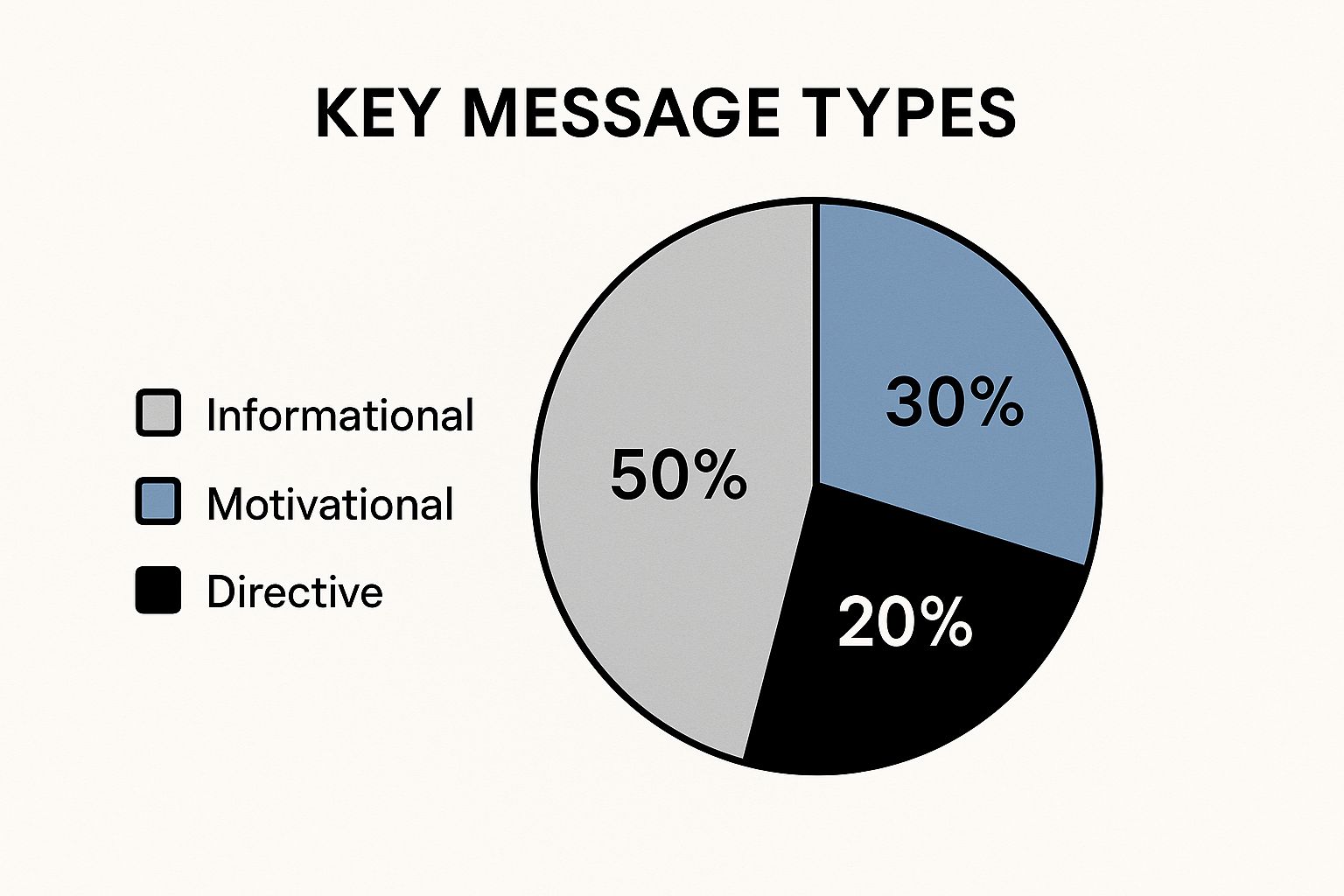Why Your Organization Needs an Internal Communications Plan

Effective communication is essential for any organization to thrive. It fosters teamwork, boosts employee engagement, and ultimately, strengthens the bottom line. In today's fast-paced business world, with teams often spread across different locations and working remotely, a robust internal communications plan is more critical than ever. Without a clear strategy, messages can get lost in the shuffle, creating confusion, frustration, and hindering overall productivity.
Consider a product launch, for instance. What happens if the marketing and sales teams aren't on the same page? Missed opportunities and a less impactful launch are likely outcomes. This scenario highlights how communication breakdowns can directly impact productivity and, consequently, the bottom line. Relying on informal communication methods often proves inadequate, especially in today’s hybrid and remote work environments.
Organizations need a more structured approach. An internal communications plan template offers a solid framework for delivering consistent and targeted messages. The value of such a plan is undeniable. A staggering 90% of company executives report experiencing negative consequences due to poor communication at work. This emphasizes the critical need for a well-structured plan that keeps all employees informed and engaged, regardless of their location. Learn more about internal communications plans: The Importance of Internal Communication Plans. You can also explore HubSpot Jira Integration.
Benefits of a Structured Internal Communications Plan
A well-defined internal communications plan offers a wealth of advantages:
-
Increased Employee Engagement: Informed and connected employees are more invested in their work.
-
Improved Productivity: Clear communication reduces confusion, enabling employees to concentrate on their tasks.
-
Stronger Team Cohesion: A strategic communication approach cultivates a sense of belonging and encourages collaboration.
-
Enhanced Organizational Alignment: Consistent messaging ensures everyone is working towards common objectives.
-
Better Crisis Management: A clear communication plan is essential for navigating challenging situations.
Developing Your Plan
Creating an effective internal communications plan requires careful thought and planning. Consider the following:
-
Objectives: Define the specific goals you aim to achieve through your communication efforts.
-
Audience: Identify your target audience and tailor your communication style accordingly.
-
Channels: Determine the most suitable communication channels for your organization, such as email, Jira intranet, or team meetings.
-
Content: Plan the type of content you'll create and share to effectively reach your audience.
-
Measurement: Establish metrics to track the success and effectiveness of your plan.
By addressing these key areas, your organization can develop an internal communications plan that fosters a more informed, engaged, and productive workforce.
Essential Components of Your Internal Communications Template

A well-structured internal communications plan is essential for a thriving workplace. This plan acts as a guide, ensuring everyone is on the same page and working towards common goals. But what makes a truly effective internal communications template? This section explores the key elements that transform a simple document into a powerful communication tool.
Defining Clear Objectives
Any successful internal communications plan begins with clearly defined objectives. These objectives should be measurable and directly tied to your overall business goals. For instance, if your company plans to introduce a new product, a related communication objective could be ensuring 90% of employees understand its features and benefits before the public launch.
This direct link between communication and business outcomes is essential for showcasing the value of your internal communication efforts.
Identifying Your Audience
Just as marketing campaigns target specific customer segments, internal communications should be tailored to different audiences within your organization. From frontline workers to senior management, each group has unique information needs and communication preferences.
Understanding these nuances is crucial for creating messages that resonate. This means knowing not only who you're communicating with, but what information they need, and how they prefer to receive it.
Crafting Compelling Key Messages
Once you've defined your objectives and identified your target audience, the next step is to craft concise and compelling key messages. These messages represent the core takeaways you want employees to remember and act upon.
For example, during a company restructuring, a key message might focus on the long-term vision and growth opportunities. These core themes will guide all communication activities and ensure consistency across various channels.
Choosing the Right Communication Channels
An effective internal communications template should specify the communication channels you'll use. This could include email, intranet platforms like Jira, instant messaging platforms like Slack, town hall meetings, or even company-wide announcements.
The channel selection should align with your audience's preferences and the type of message being conveyed. Using a mix of channels can often maximize reach and engagement. For urgent updates, a platform like Slack might be best, while broader company news might be better suited for email or an intranet post. Efficient communication often involves streamlining document processes. Learn more about document workflow management.
Content Calendar and Frequency
Maintaining a consistent flow of information is crucial. A well-defined content calendar within your template can help achieve this. This calendar outlines the topics, content formats, and publishing schedule for your internal communications.
Determining the right frequency is key. Too many messages can lead to information overload, while too few can leave employees feeling out of the loop. Finding the right balance keeps everyone informed and engaged.
Measuring Success with Metrics
Finally, every internal communications plan needs a way to measure its success. Defining specific metrics tied to your objectives allows you to track progress and make adjustments as needed.
These metrics could include employee survey results, email open rates, intranet page views, or feedback from team meetings. This data-driven approach demonstrates the impact of your communication efforts.
To further elaborate on the key components, let's examine a breakdown in the following table:
To better understand the essential building blocks of a robust internal communications strategy, the table below provides a detailed breakdown of each component:
Essential Components of an Internal Communications Plan
| Component | Purpose | Implementation Considerations |
|---|---|---|
| Objectives | Define the specific, measurable, achievable, relevant, and time-bound (SMART) goals of the communication plan. | Align objectives with overarching business goals. Use clear and concise language. |
| Audience | Identify the specific groups within the organization that the communication plan targets. | Consider different employee roles, departments, locations, and communication preferences. |
| Key Messages | Develop concise and compelling core takeaways for employees to remember and act upon. | Ensure messages are consistent with the overall communication objectives and resonate with the target audience. |
| Communication Channels | Determine the platforms and methods used to deliver messages. | Select channels based on audience preferences, message urgency, and desired reach. Consider a mix of channels for optimal engagement. |
| Content Calendar and Frequency | Establish a schedule for content creation and distribution to maintain a consistent flow of information. | Plan topics, formats, and publishing timelines. Determine the appropriate frequency to avoid information overload. |
| Metrics | Define specific measures to track the effectiveness of the plan. | Select metrics that align with communication objectives and allow for data-driven adjustments and improvements. |
This table provides a framework for building a comprehensive and effective internal communications plan. By addressing each component thoughtfully, you can ensure your communications are targeted, engaging, and ultimately contribute to the success of your organization.
Selecting the Right Communication Channels for Maximum Impact
Choosing the right communication channels is crucial for a successful internal communications plan. Think of it like selecting the right tool for a specific task. A hammer works wonders for nails, but it's not much help with screws. This section will guide you in identifying the optimal channels for various message types and audience segments, making sure your message truly connects.
Understanding the strengths and limitations of each channel is essential for maximizing their impact.
Understanding Channel Strengths and Limitations
Different communication channels offer unique advantages. Email excels at formal announcements and conveying detailed information. Team meetings, whether held in person or virtually, promote discussions and foster a sense of community. Instant messaging platforms are perfect for quick updates and casual exchanges. Digital signage effectively reaches broad audiences with concise messages. Intranet platforms such as Jira can serve as a central hub for resources and updates. For example, check out this guide on managing out-of-office time in Jira.
However, each channel also has its drawbacks. Email inboxes can become overloaded, meetings can be time-consuming, and instant messaging can be distracting. Recognizing these nuances is key to developing a multi-channel strategy that optimizes effectiveness.
Tailoring Channels to Message Types
The nature of your message should determine the channel you use. Informational updates might be best delivered via email or an intranet post. However, motivational messages might be more impactful through video or in-person events. The following infographic depicts a typical distribution of message types within an internal communications plan:

As illustrated, informational messages constitute the largest portion (50%), followed by motivational (30%) and directive messages (20%). This underscores the need for channels capable of disseminating both detailed information and engaging content.
Crafting an internal communications plan involves several key steps, including identifying effective channels. In 2025, internal communicators indicated that email remains a primary channel, with 85% relying on it. This is complemented by the growing use of video and in-person events, crucial for building community and engagement. Learn more about this in the Internal Communications Trends Report 2025.
To illustrate the diverse strengths and weaknesses of various communication channels, let's examine a comparison table.
The following table, "Communication Channel Comparison," provides a detailed overview of different channels, highlighting their suitability for various message types and audience scenarios.
| Channel | Best For | Limitations | Engagement Level | Implementation Complexity |
|---|---|---|---|---|
| Formal announcements, detailed information sharing | Can be overwhelming, easily ignored | Moderate | Low | |
| Team Meetings (In-person/Virtual) | Discussion, team building, brainstorming | Time-consuming, scheduling conflicts | High | Moderate |
| Instant Messaging | Quick updates, informal communication, urgent matters | Distracting, not suitable for complex information | Moderate to High | Low |
| Digital Signage | Reaching large audiences with concise messages, company-wide announcements | Limited space for details, requires strategic placement | Moderate | Moderate |
| Intranet Platforms (e.g., Jira) | Centralized resources, document sharing, project updates | Requires regular maintenance and updates, user adoption can be a challenge | Moderate | High |
This table highlights the importance of selecting the appropriate channel based on the specific message and target audience. While email excels for detailed information, its engagement level can be lower than interactive meetings or instant messaging. Intranet platforms offer centralization, but their implementation can be more complex.
Creating Channel Hierarchies and Governance
To avoid information overload, organizations should establish channel hierarchies. This involves prioritizing specific channels for certain types of information. For urgent updates, instant messaging may be preferred, while less time-sensitive information can be shared via email or the intranet. You might be interested in tools like the Out-of-Office Assistant for Jira.
Channel governance ensures consistent messaging. This means establishing guidelines for tone, branding, and content across all platforms. Effective governance maintains a cohesive brand voice without hindering authentic communication. This structured approach streamlines communication, promotes clarity, and enhances employee engagement.
Building Your Internal Communications Plan: A Blueprint for Success

Now that we understand the core elements and optimal channels for internal communications, let's create an internal communications plan template that delivers. The goal isn't a static document, but a dynamic system that boosts engagement and achieves tangible results.
Conducting a Communication Audit
A successful plan begins with understanding your existing communication environment. This requires a thorough communication audit. Instead of relying on guesswork, gather concrete data. Employee surveys, interviews, and focus groups can uncover what's actually happening.
This process often reveals unexpected communication gaps, isolated information pockets, and unmet employee needs. These insights are essential for shaping the next steps.
Setting SMART Communication Objectives
Your communication objectives should directly support your overarching business goals. This connection highlights the value of internal communications and ensures company-wide alignment. These objectives must be SMART: Specific, Measurable, Achievable, Relevant, and Time-bound.
For example, instead of "improve employee morale," try "increase employee participation in company surveys by 15% within the next quarter." This specific goal allows for precise tracking and measurement.
Mapping Stakeholder Information Needs
Different stakeholders require different information. Frontline staff may need immediate updates on production, while executives need high-level performance summaries. Mapping these needs ensures everyone receives the right information at the right time.
Understanding preferred communication styles and channels is also key. Some employees prefer email, while others respond better to visuals or in-person meetings.
Crafting Messages That Cut Through the Noise
In today's busy workplace, messages need to be clear, concise, and engaging. Avoid jargon and complex language; use plain language that resonates. This is crucial for communicating important changes or updates.
Tailor messages to different stakeholder groups. A sales team's motivators differ from an engineering department's. Customization maximizes impact. Streamlining communication often involves efficient document management. For more on this, see our article on document workflow management.
Building a Realistic Content Calendar
A content calendar brings structure and consistency. However, it's essential to be practical. A calendar packed with daily posts is unsustainable. Start small and gradually increase frequency as your team's capacity grows.
Your calendar should detail topics, formats, channels, deadlines, and responsibilities. This organization keeps everyone aligned and prevents last-minute rushes. For more on managing time off, see our guide on How to master employee time-off tracking.
Securing Executive Buy-In and Demonstrating ROI
Executive support is crucial for securing resources and ensuring long-term success. Show your plan's value by connecting communication objectives to measurable business results.
Track key metrics like employee engagement, productivity, and customer satisfaction. This data proves the ROI of your efforts and justifies continued investment, positioning internal communication as a strategic function. By following these steps, you'll create an internal communications plan that immediately boosts engagement and sets the stage for lasting communication success.
Measuring What Matters: Tracking Communication Effectiveness
A well-crafted internal communications plan template is only as good as its execution. But how do you know if your communications are truly effective? This section moves beyond vanity metrics, such as email open rates, and explores the real indicators of successful communication. This means prioritizing metrics that demonstrate tangible business value.
Beyond Vanity Metrics: Measuring Real Impact
While open rates and click-throughs offer a glimpse into engagement, they don't tell the whole story. True communication effectiveness lies in observable changes in employee behavior, improved productivity, and stronger alignment with company objectives. For example, if your internal communications plan aimed to boost product knowledge within sales teams, a key metric would be an improvement in the sales team's performance after the communication rollout.
Qualitative feedback is also essential. Surveys and focus groups can offer invaluable insights into how employees perceive communication efforts. This qualitative data complements quantitative metrics, providing a more comprehensive understanding of the impact.
Practical Measurement Approaches for Any Organization
Measuring communication effectiveness doesn't have to be complex. Even small organizations can implement simple yet effective tracking methods. A short survey after a company-wide announcement, for instance, can help gauge message comprehension. Digital analytics tools, such as those offered by Google Analytics, can track intranet page views and document downloads, revealing which content resonates most with employees.
Larger organizations might leverage more robust systems, integrating communication data with key performance indicators (KPIs). Tracking customer satisfaction alongside internal communication metrics, for example, can uncover valuable correlations and highlight the impact of effective communication.
Establishing Benchmarks and Tracking Progress
Setting realistic benchmarks is crucial. This involves understanding your current position. Conducting a baseline assessment before implementing your internal communications plan establishes a benchmark against which future progress can be measured. For more insights on productivity, check out this article: How to Master Team Productivity With Jira.
Tracking should be a continuous process. Regularly monitoring key metrics reveals emerging trends, highlights successes, and pinpoints areas for improvement. This continuous improvement cycle ensures your internal communications plan remains relevant and effective.
Translating Data Into Compelling Narratives
Data is only valuable if it can be understood and acted upon. Transforming raw data into compelling narratives is crucial for showcasing the value of your internal communications strategy to leadership. Instead of simply reporting increased intranet traffic, for example, connect that increase to specific improvements, such as better employee knowledge and, ultimately, positive business outcomes.
This data-driven approach justifies continued investment in internal communications. It positions communication as a strategic business function, not just an expense. By focusing on the right metrics, using practical tracking methods, and effectively communicating results, organizations can ensure their internal communications plan drives real, measurable business impact.
Overcoming Communication Roadblocks: Solutions That Work
Launching an internal communications plan, even with a solid template, can be tricky. Organizations frequently run into obstacles that can impact how well employees communicate. This section explores common roadblocks and offers practical solutions to address them.
Information Overload and Message Inconsistency
One of the biggest hurdles is information overload. When employees are constantly flooded with emails, messages, and updates, it becomes difficult to discern what's truly important. This can lead to crucial information being missed. Inconsistent messaging across different channels can also cause confusion and undermine trust.
Solution: Create clear communication hierarchies, designating specific channels for certain types of information. Urgent updates might be best suited for instant messaging platforms or a dedicated communication app like Slack. Less urgent news can be disseminated through email newsletters or the company intranet. Standardized messaging templates can help maintain consistency across all platforms. For further reading, check out this resource on absence management strategies.
Reaching Non-Desk Workers
Connecting with employees who aren't regularly at a computer, such as frontline or field staff, presents its own set of communication challenges. Traditional channels like email are often ineffective for these employees, necessitating alternative approaches.
Solution: Implement communication methods tailored to the needs of these employees. Mobile apps, digital signage in break rooms, or regular team briefings can help ensure these essential team members stay informed. Visual communication tools, such as infographics or short videos, can also be helpful.
Breaking Down Departmental Silos
Communication breakdowns frequently occur between departments, resulting in information silos. This happens when knowledge isn't shared effectively, hindering collaboration and creating inefficiencies.
Solution: Promote cross-departmental communication through regular meetings, collaborative projects, or shared communication platforms. Encouraging employees to share insights and expertise across teams cultivates a more transparent and collaborative atmosphere.
Managing Multi-Generational Workforces
Different generations often have varying communication preferences. Some may prefer email, while others gravitate toward instant messaging or face-to-face interactions. Addressing these preferences is vital for effective communication.
Solution: Implement a multi-channel approach, utilizing diverse communication methods to accommodate individual preferences. Regularly conduct communication audits to gauge employee preferences and fine-tune strategies.
Building Two-Way Feedback Loops
Internal communication should be a two-way street. Creating avenues for two-way feedback builds trust and enhances communication effectiveness. Employees need to feel heard and have opportunities to voice their thoughts and concerns.
Solution: Implement regular employee surveys, feedback forums, or town hall meetings to gather input. Foster open dialogue and demonstrate that employee feedback is valued and acted upon where appropriate.
By proactively tackling these communication challenges, organizations can build stronger internal communication systems. This, in turn, leads to increased employee engagement, a more robust company culture, and greater overall success. Tools like the Out-of-Office Assistant for Jira Cloud can help streamline team communication and boost productivity. Learn more about improving team workflows.
